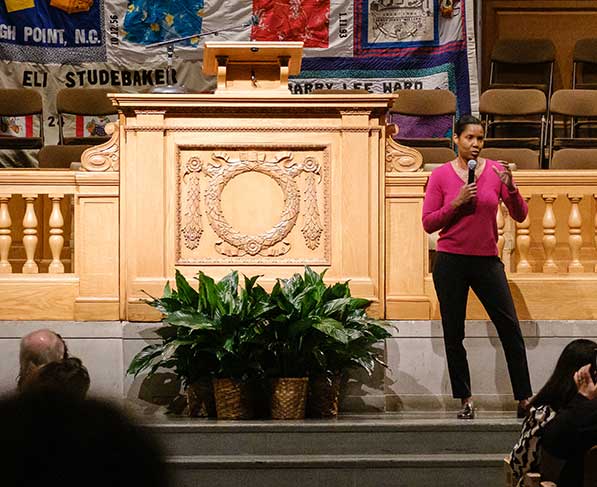
On March 3, 2020, a soft-spoken physician named Dr. Matthew Hepburn ascended the TEDMED stage at the Westin Waterfront Hotel in Boston to deliver a long-planned talk on his life’s work: preventing pandemics. His timing was apt. That day, the Centers for Disease Control and Prevention had just announced 60 cases of SARS-CoV-2 in the United States, and a cruise ship full of infected passengers would soon be stranded off the California coast.
Hepburn had spent 23 years in the US Army as an infectious disease specialist. Now, before a nervous audience of medical professionals who had been bumping elbows rather than shaking hands, he identified three keys to fighting pandemics: advanced technologies, global cooperation, and political will. “We can mount the most effective pandemic defense the world has ever seen,” he predicted. “Instead of being divided, why don’t we as a global community unite and fight this pandemic as a team?”
Before leaving the podium, Hepburn promised never to quit fighting to end pandemics once and for all. By the end of that week, he would be immersed in the division and dysfunction of the US coronavirus response under President Trump. And before long, he was working 16-hour days on Operation Warp Speed, which successfully accelerated the development of COVID vaccines.
Today, Hepburn serves as senior adviser for pandemic prevention within the White House Office of Science and Technology Policy, and as cochair of a federal steering committee on pandemic innovation. His responsibilities include coordinating pandemic drills and exercises among multiple federal agencies. His goal, he says, is for the government to plan for pandemics with the same level of seriousness it brings to preparing for hurricanes or wars. “The American public should expect that every aspect of our government should be in this for the long term,” he says.
And yet, as the COVID-19 crisis enters its fourth year, with more than 1 million Americans dead and the highly infectious XBB.1.5 variant contributing to rising case counts, the goal of eliminating pandemic threats seems as distant as ever. In the US, our political will is flagging. Our public health workforce is exhausted and demoralized. Our deep political divisions have impacted everything from funding streams to a basic belief in science. The anti-vax movement is growing more organized by the day. And scientists fear that an incoming Republican Congress—having barely seated a Speaker—is more likely to demonize their work in upcoming hearings than to support its effective deployment.
“Since the beginning of the pandemic, our public health institutions were unable to persuade a large portion of the population to get vaccinated or boosted or wear a face mask,” says Dr. James Lawler, codirector of the Global Center for Health Security at the University of Nebraska Medical Center. “I think it would be hard to claim that trust and confidence in those institutions has improved since then.” According to data analyzed by Kathleen Hall Jamieson, director of the Annenberg Public Policy Center at the University of Pennsylvania, politicized topics are the ones most likely to cause Americans to question the “recommendations of the federal health agencies.” Unfortunately, she says, “COVID polarized.”
The need to repair these divisions—and build a system of speed and trust—is especially acute given that the next pandemic may be just around the corner. Even while battling COVID-19, we have contended with a global monkeypox emergency and an Ebola outbreak in Uganda. Taken together, globalization, climate change, deforestation, the proliferation of new biotechnologies, and inadequately regulated laboratories have ratcheted up the risk of new outbreaks, experts say.
Some fear SARS-CoV-2 could end up looking like a dry run for something far worse. “SARS CoV-3 could be around the corner,” says Lawler. If you were to combine the 10% fatality rate of SARS-CoV-1, which first emerged in 2002, with the transmissibility of SARS-CoV-2, he says, you’d have the recipe for “a catastrophic, Armageddon-type pandemic.”
To assess the question of how prepared the US is to face future pandemic threats, Vanity Fair spoke to more than 20 doctors, scientists, policy analysts, and other experts. The takeaway was clear: We need to up our game. At the very least, the experts said, three key areas require urgent attention: overhauling public health messaging, effectively deploying the private sector, and increasing global transparency.
Progress on these fronts costs money, which has dried up, leaving viruses with the upper hand. “That’s one of the things about viruses: They can’t live outside a human host,” says Valerie Reyna, director of the Human Neuroscience Institute at Cornell University. “They need all of us to cooperate in transmitting them.”
Overhauling Public Health Messaging
There is little doubt that trust and social cohesion can save lives during a pandemic. For evidence, one can look to Japan, where fewer than 49 people per 100,000 have died of COVID, as compared with the US toll of more than 330 per 100,000. The Japanese government did not mandate vaccines or masks. Rather, peer pressure did the work, as The New York Times has reported. There, masks are referred to as face underwear. As in: You’d be embarrassed not to wear them. The Japanese government also drilled into public consciousness early on the dangers of what became known as the “Three C’s”: closed spaces, crowded places, and close-contact settings. The ubiquity of that phrase, which became Japan’s buzzword of 2020, almost certainly saved lives.
But would face underwear cut it in the US, where a Beverly Hills doctor and leader of the anti-vax movement was among those arrested for storming the Capitol during the attempted insurrection on January 6? Can the Three C’s compete with Florida governor Ron DeSantis, a Republican who in December got approval from the Florida Supreme Court to launch a grand jury investigation into COVID-19 vaccines?
“We are a divided country, and a divided country cannot be prepared,” says Ali Mokdad, a professor and chief strategy officer for population health at the University of Washington. Mokdad has spent the pandemic modeling its path, and confirmed that outcomes can diverge widely based on whether or not people follow public health guidance.
Americans, however, are not going to wake up one morning and start unanimously respecting authority and following instructions. So it’s incumbent on public health officials to figure out how to communicate with us as we are, not how they might like us to be.
Confusing and jumbled health guidance from the CDC, at times at odds with science, has helped fuel public suspicion of medical authorities, experts say. At the height of the omicron wave, 10 days of recommended isolation became five, with no requirement of a negative test. Six feet of distance at schools became three, also with little clarity. “Our CDC has been dysfunctional in both administrations,” says Eric Topol, a professor of molecular medicine at Scripps Research.








